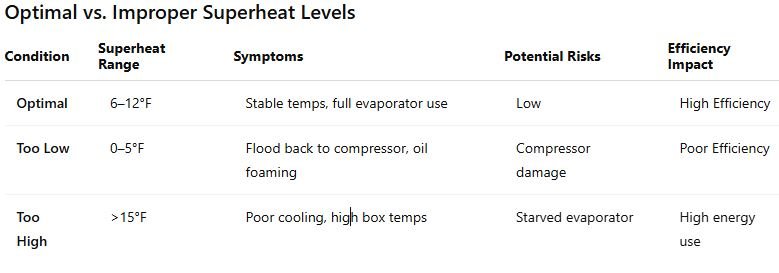From the Field: Mastering Superheat in Commercial Refrigeration: The Key to Efficient Cooling Systems
In the world of commercial refrigeration, accurate control of the refrigeration cycle is vital to keeping your walk-in coolers, reach-in display cases, and freezer units running at peak performance. One of the most crucial indicators of proper operation is Superheat—a parameter that, when properly understood and managed, can be the difference between reliable equipment and costly service calls.
This article explores what superheat is, why it matters, how to measure it manually, and how it affects the health of your refrigeration system. Whether you're a grocery store manager, convenience market owner, or operate refrigerated storage for liquor stores, produce stands, or wholesale warehouses, this guide is packed with actionable insights.
What Is Superheat?
Superheat is the temperature of a vapor refrigerant above its boiling (saturation) temperature at a given pressure. It tells us that all the liquid refrigerant has evaporated into gas before entering the compressor.
Formula:
Superheat = Measured Suction Line Temperature - Saturation Temperature (from pressure)This measurement confirms two key facts:
All liquid refrigerant has boiled off before reaching the compressor.
The compressor is protected from liquid slugging.
Why Is Superheat Important?
In systems with Thermostatic Expansion Valves (TXVs) or Capillary Tubes, controlling superheat ensures that:
The evaporator coil is fully utilized.
The compressor receives vapor, not liquid (which can cause damage).
Energy efficiency is maximized.
Optimal superheat levels (typically 6°F–12°F for most walk-in coolers) improve system efficiency, compressor longevity, and temperature stability in commercial refrigeration systems used in gas stations, grocery chains, and restaurants.
Tools Needed to Measure Superheat
To manually calculate superheat, the following tools are required:
Digital Manifold Gauge Set or Analog Gauges – To measure suction pressure.
Temperature Clamp Probe – To measure suction line temperature.
PT (Pressure/Temperature) Chart or App – To convert suction pressure to saturation temperature.
Refrigerant ID Tag – Ensure the correct refrigerant type (e.g., R-404A, R-448A).
Step-by-Step: How to Measure Superheat Manually
Step 1: Connect your gauges to the suction service port of the evaporator outlet or compressor inlet.
Step 2: Attach a temperature probe to the suction line near the port—ensure it's insulated from ambient air.
Step 3: Record the suction pressure and use a PT chart to determine the saturation temperature.
Step 4: Measure the actual line temperature using the clamp.
Step 5: Subtract the saturation temperature from the measured suction line temperature.
Example Calculation:
Measured suction line temp = 48°F
Saturation temp (based on 62 psi R-404A) = 34°F
Superheat = 48 - 34 = 14°F
Scientific Principle Behind Superheat
Superheat hinges on thermodynamic phase change. As a liquid refrigerant absorbs heat in the evaporator, it reaches its saturation point, where it turns to vapor. Adding more heat raises its temperature without increasing pressure—this added heat is the superheat.
This concept is governed by Gay-Lussac's Law (Temperature ∝ Pressure at constant volume) and latent heat of vaporization in phase transition.
Optimal vs. Improper Superheat Levels
Troubleshooting Abnormal Superheat
High Superheat Symptoms:
Warm product temperatures
Compressor running hot
Ice forming only at evaporator inlet
Possible Causes:
Low refrigerant charge
TXV restriction or malfunction
Plugged filter-drier
Remedies:
Leak check and recharge refrigerant to specs
Test and replace faulty TXV
Replace restricted filter-drier
Low Superheat Symptoms:
Compressor short cycling
Oil in suction line
Ice on suction line or compressor
Possible Causes:
Overcharged system
TXV overfeeding
Sensing bulb not secured properly
Remedies:
Remove excess refrigerant
Adjust or replace TXV
Secure/relocate sensing bulb to correct spot on suction line
Efficiency Benefits of Proper Superheat
Keeping superheat within range helps ensure:
Full utilization of the evaporator coil
Reduced compressor cycling and energy use
Stable box temperatures (essential for grocery freezers, beer caves, and walk-in coolers)
Final Thoughts for Business Owners
Whether you're operating a cold vault in a liquor store, maintaining refrigerated produce shelves in a supermarket, or running walk-in freezers in a wholesale warehouse, superheat should be part of your regular maintenance check.
At Jadeco Commercial Refrigeration, our certified technicians are trained to check, calibrate, and optimize superheat settings on all commercial refrigeration systems. Proper superheat control ensures your equipment runs efficiently, safely, and cost-effectively.
Contact us today for maintenance programs, emergency service, or new refrigeration system installations tailored for gas stations, convenience markets, grocery stores, and retailers who can’t afford warm coolers.
Keywords: Superheat Refrigeration, Walk-In Cooler Repair, Commercial Refrigeration Maintenance, TXV Adjustment, Low Superheat Symptoms, High Superheat Fix, Refrigeration Contractors for Grocery Stores, Display Case Refrigeration, Convenience Store Cooler Service, Warehouse Freezer Maintenance


